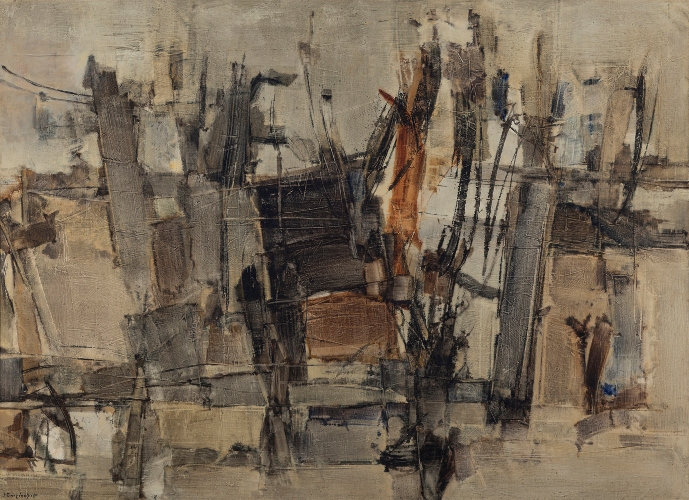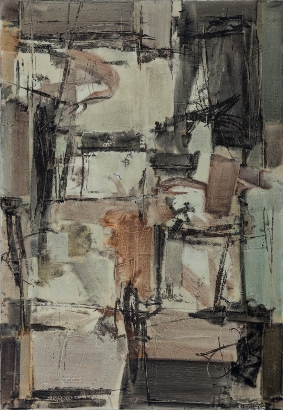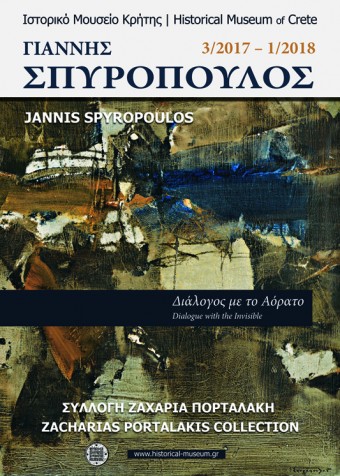Announcing the official opening, on Saturday 18 March at 19:30 at the Historical Museum of Crete, of the exhibition on Jannis Spyropoulos, one of the most important Greek artists of the 20th century, featuring works from the Zacharias Portalakis Collection. The exhibition, entitled Dialogue with the Invisible, follows the first Portalakis Collection exhibition at the Historical Museum of Crete, which showcased representative works by pioneering artists Konstantinos Parthenis, Yannis Tsarouchis, Christos Kapralos and Theodoros Stamos, next to the permanent collection of 65 post-Byzantine portable icons (15th-early 20th c.) donated to the Society of Cretan Historical studies by Zacharias Portalakis.
Jannis Spyropoulos (1912-1990) is considered the most emblematic and internationally recognised Greek representative of Abstraction. Thirteen selected works are presented at the Historical Museum of Crete: 12 works from the Zacharias Portalakis Collection (Monday Morning, Erymanthus, Idi, Yesterday at Sounion, Alfeios, Skyros, Doric, Alcar No 1, Stasimon No 7, Diptych No 3, Strophe No 13, 1890) and the monumental Triptych A from the Jannis & Zoe Spyropoulos Foundation.

Most of these works were produced in the 1960s, the peak period of the artist’s search for an abstract vocabulary in his creations. The works are characterised by gestural marks, symbolic designs, and the textural reworking of the canvas surface, which seems, in a process of intensive intervention and revision, to have been constructed in terms of colour.
As Yiannis Ch. Papaioannou explains, during this period, besides the three basic elements of his work (scoring, collage and brushwork), “the painter uses earth colours, the brightness value withdraws within them, is transformed into heat and acts as the catalyst for dramatic painterly events highlighted by the ingenious final waxing technique”.
Spyropoulos came late to aniconic art. He reached Abstraction “through successive phases dictated by inner necessity” and became established as its classical representative. The turning-point came when he was awarded the UNESCO Prize at the 1960 Venice Biennale, leading to his wider international recognition.
It is these works of the 1960s which are exhibited at the Historical Museum of Crete. There the visitor will discover the dramatic moulded elements and tensions intrinsic to Spyropoulos' compositions of the period. The physicality of the material, with its sudden rifts, burning, scraping, scoring and collage, expresses “the drama of creation and destruction”.
 Among the works in the exhibition, a small canvas shows, lastly, how in the mature 1980 phase a combination of disparate materials (textiles, sacks, newspapers) is now organically incorporated, structuring the surface and expressing a viewpoint that ultimately surpasses the limits of Abstraction: “This is an artistic attitude,” explains Eleni Vakalo, “with its origins in the grand tradition of European painting and with a wider range of possible applications. Spyropoulos realized it in its pure form. Following the principles of Αbstraction, he traced it within the act of painting itself. He deposited it as a constituent element of painting, and in this sense he delivers his work to the younger generation”.
Among the works in the exhibition, a small canvas shows, lastly, how in the mature 1980 phase a combination of disparate materials (textiles, sacks, newspapers) is now organically incorporated, structuring the surface and expressing a viewpoint that ultimately surpasses the limits of Abstraction: “This is an artistic attitude,” explains Eleni Vakalo, “with its origins in the grand tradition of European painting and with a wider range of possible applications. Spyropoulos realized it in its pure form. Following the principles of Αbstraction, he traced it within the act of painting itself. He deposited it as a constituent element of painting, and in this sense he delivers his work to the younger generation”.
As part of the exhibition, the Society of Cretan Historical Studies has also planned lectures, musical events and specially designed (and always free) educational programmes. The exhibition will run until the end of January 2018.
A few words on Jannis Spyropoulos
Jannis Spyropoulos (born in Pylos in 1912) studied from 1933 to 1938 at the Athens School of Fine Arts, where his teachers were Spyridon Vikatos, Umberto Argyros and Epaminondas Thomopoulos. He then, with the support of a scholarship grant from the Academy of Athens, continued his studies in Paris, both at the École des Beaux-Arts (where his teacher was Charles Guérin), and at free academies. The outbreak of World War II obliged him to interrupt his studies and return to Greece.

He exhibited his work for the first time in 1950, with a solo exhibition at the Parnassos Gallery in Athens. There followed a number of solo and group exhibitions in Greece and internationally. In 1960 he was honoured with the UNESCO prize at the 30th Venice Biennale and in 1961 he received the Gold Medal of the city of Ostend, Belgium. He was made Commander of the Order of the Phoenix in Athens in 1966 and awarded the Gottfried von Herder prize in Vienna in 1978. Jannis Spyropoulos died in Athens on 18 May, 1990. In November of the same year the Jannis & Zoe Spyropoulos Foundation was established, housed in the Spyropoulos family home in Ekali. Works by the artist are now on display in major Museums of Modern Art, from New York and New Zealand to Tokyo and London.
Catalogue and Brochure
The HMC Exhibition is accompanied by a bilingual brochure and a large-format bilingual catalogue (Greek & English) with a wealth of colour photographs and texts by Yiannis Papaioannou, Kostas Ioannidis and Olga Daniylopoulou. The printed material is designed by Dimitris Kalokyris, a long-term HMC collaborator.
A poster and postcards of paintings by Jannis Spyropoulos will also be available in the Museum Shop.
Exhibition Organisers
Special mention must also be made of the scientific, administrative and technical staff of the Historical Museum of Crete who contributed to the project, coordinated by Alexis Kalokerinos and exhibition curator Aggeliki Baltatzi.
Tours
The SCHS is planning tours of both exhibitions by the Museum scientific staff, prioritizing vulnerable social groups, such as our fellow-citizens using the Social Space of the A. & M. Kalokerinos Foundation, and the residents of the Foundation Nursing Home.
Official Opening
The official opening of the exhibition Jannis Spyropoulos / Dialogue with the Invisible, organized with the support of the Region of Crete and open to the public until January 2018, will take place on Saturday 18 March at 19:30. The authors of the Catalogue, art historians Yiannis Papaioannou and Kostas Ioannidis, and Mrs Olga Daniylopoulou, Director of the Jannis Spyropoulos Museum, will speak about Jannis Spyropoulos in the HMC Amphitheatre. Mr Papaioannou will also give guests a tour of the exhibition. The exhibition will be opened by Mr Stavros Arnaoutakis, Regional Governor of Crete. Information: 2810-283219, Ext. 101, Admission: Free



